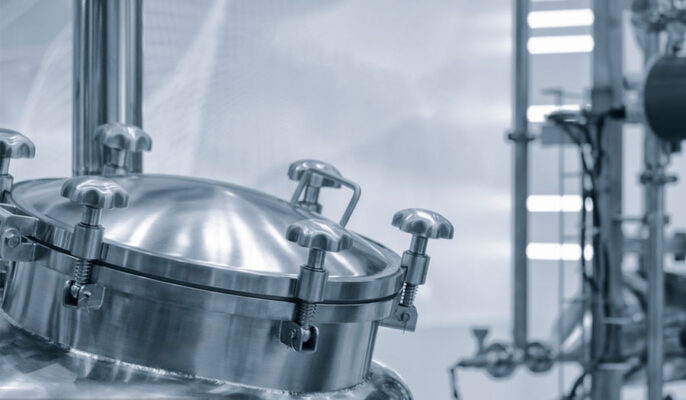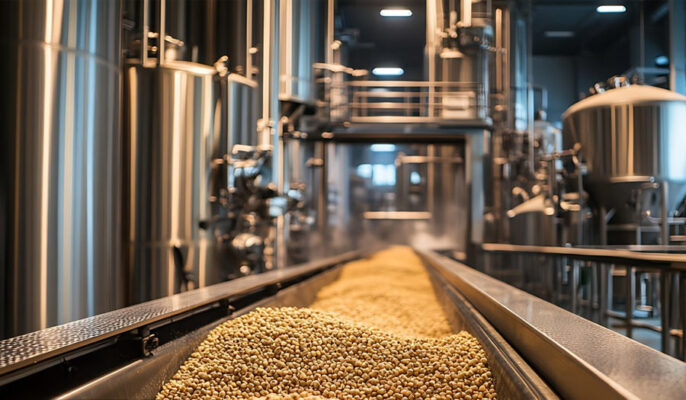計算する 醸造設備 出力は、生産効率を確保し、醸造工程における資源配分を最適化するための重要なステップです。ビール醸造設備の生産高は、醸造設備の種類とサイズ、1日に醸造するバッチ、発酵タンクのサイズと数、ビールの発酵サイクルによって異なります。設備によって、敷地の広さ、高さ、水、電気などの条件が異なり、場所によっても異なります。ビールを醸造する際、醸造設備がどのようにビールの生産量を計算するのかを理解することは、生産を最適化し、一貫性を保ちたい醸造業者にとって極めて重要です。
すべてのビールは同じではない
醸造所の年間生産量を計算する際に考慮すべきことのひとつに、缶に詰められている時間があります。ビールがパッケージされるまでに、缶の中でどれくらいの期間置かれるのでしょうか?ビールを醸造した場合、おそらく出来上がるまでに4~6週間は缶の中に置かれるでしょう。ビールが缶の中に置かれる期間が長ければ長いほど、醸造できるビールの量は少なくなります。
ビール製造設備の概要
マッシュタン
マッシュタンは麦芽と水を混ぜ、加熱して糖分を抽出する装置。マッシュプロセスの効率は、最終的な麦汁の糖度と量に直接影響する。
計算方法:もろみ効率は、もろみ前ともろみ後の麦汁の量と糖度を測定することで計算できる。通常は、もろみ前ともろみ後の麦汁の比重差と体積変化を測定する。
沸騰ケトル
煮沸釜は麦汁を煮沸し、ホップを加えるために使用する。この過程で麦汁は蒸発により減少し、最終的な収量に影響する。
計算方法沸騰損失は、沸騰時間、温度、ケトル内の麦汁容積の変化をモニターすることで推定できる。蒸発率は通常、最終麦汁量を計算するのに使われる。
発酵タンク
発酵タンクは一次発酵と後発酵に使用される。発酵中のビールはガスや沈殿物の発生により容量が変化します。
計算方法:最終的なビール収量は、発酵開始時と終了時の容積を測定し、発酵ロスの記録と組み合わせて計算することができる。発酵タンクの容積監視システムは通常、リアルタイムデータを提供する。

フィルター
フィルターは、発酵後のビールから固形物を取り除き、ビールの透明度と安定性を確保するために使用される。
計算方法濾過の過程で、固形物の除去によりビールの体積は減少します。濾過前後の体積変化を記録することで、濾過損失を計算することができます。
包装設備
包装設備はビールを瓶、缶、樽に充填し、密封します。また、包装の過程でも一定のロスが発生します。
計算方法:包装前の容積と実際の充填量を記録することにより、包装ロスを計算することができる。通常、包装機器の計量システムが正確なデータを提供する。
ビール収量計算の主な要因
- 麦汁の歩留まりビールの歩留まりを計算する最初のステップは、醸造工程で生成される麦汁の量を測定することです。これは通常、醸造機器に組み込まれた容量センサーや流量計を用いて行われる。
- 比重:比重は水に対する麦汁の密度を測定し、発酵可能な糖分の量を推定するのに役立つ。醸造家は比重計や屈折計などの道具を使い、発酵の前後に比重を測定する。
- アルコール度数:ビールのアルコール度数は、発酵前後の比重差に基づいて計算される。この差は、醸造過程で糖分がどれだけアルコールに変換されたかを示す。
- 醸造効率:醸造工程の効率は糖分の抽出と利用に影響する。
- 酵母の種類と発酵条件酵母の種類や発酵温度の違いは、風味の発達や最終的なビールの特徴に影響を与えます。
醸造所の生産量計算
簡単のため、年間20回の発酵とコンディショニングの生産サイクルを計算する。CCTユニット・タンクでの発酵と熟成・貯蔵。
我々は計算する: 平均的な発酵+コンディショニングのサイクルは17~18日で、年間350日÷17日=年間20生産サイクル。

醸造所の容量の計算 - セラータンク
醸造プロセスで使用できるタンクにはいくつかの種類がある:
- 発酵タンク
- 透明なビールタンク
- 水平熟成タンク
- サービングタンク
あなたが選ぶビールタンクは、醸造所の生産量と人件費に影響します。例えば、ビールパブを経営しているのであれば、タンクは有効な選択肢です。ビールタンクをクーラーに保管し、バーでタンクから直接ビールを注ぐ醸造所もあります。これは労働力を節約するので、樽ビールは生ビールに使用されません。
醸造所の容器の数
醸造所の設計は、その場で醸造できるビールの量にも影響します。ホテル、バー、醸造所、レストランで使用される家庭用醸造設備やクラフトビール醸造設備の種類は、一般的に500Lまたは1000Lの2槽式、2槽式3槽式、2槽式+温水ボイラーを使用します。1日に1-2バッチを糖化する。手間や労働強度などを考慮すると、1日1バッチを使用する。
最も一般的なセットアップだ:
- 3容器システム:マッシュ/ろ過タンクとケトル/ボルテックスタンクの組み合わせ
- 3容器システム:マッシュ/ろ過タンクとケトルとボルテックスタンクの組み合わせ、またはマッシュとろ過タンクとケトル/ボルテックスタンクの組み合わせ
- 4容器システム:独立したマッシュ、ろ過、ケトル、ボルテックスタンク
醸造所の容器の数が多ければ多いほど、1日に醸造できるビールの量は増えます。2容器システムなら2回醸造できるかもしれないが、1日が長くなる。醸造所によっては5、6容器システムを持ち、1日に6回以上醸造できるところもある。醸造プロセスにおいて、醸造所の生産量を制限するのはセラータンクの数ではなく、醸造所の設計である。

醸造所の生産高計算プロセス
データ収集
- 原材料データ:麦芽、ホップ、水などの各原材料の投入量を記録する。
- プロセスデータ:もろみ、煮沸、発酵、濾過、包装中の容量と品質データを記録する。最新の機器には通常、センサーと自動記録システムが装備されており、このデータをリアルタイムで収集する。
データ計算
マッシュ効率の計算:マッシュ前後の麦汁の量と糖度からマッシュ効率を計算する。
- 計算式は次の通り:マセフィシェンシー=抽出された可溶性糖の量÷麦芽に投入された糖の量
- 煮沸損失の計算:煮沸前後の麦汁の体積差を測定し、蒸発率を組み合わせることで煮沸損失を推定する。
- 発酵ロスの計算:発酵前後のビール量の変化を記録し、発酵中に発生するガスと沈殿物を合わせて発酵ロスを計算する。
- ろ過損失計算:ろ過前後の体積差からろ過損失を計算する。
- 包装ロス計算:包装前の体積と実際の充填体積を測定し、包装ロスを計算する。
データ分析
- 収量予測:過去の生産データと現在の生産状況を組み合わせて将来の生産量を予測する。
- 品質管理:生産データを分析し、各リンクの効率を確保し、製品の一貫性を維持する。
- コスト管理:各リンクのロスデータを基に、生産工程とコスト管理を最適化。
結論
醸造設備がどのようにビールの生産量を計算するのかを理解することは、醸造業者が効率を高め、品質基準を維持するために不可欠です。これらの計算をマスターし、高度な醸造技術を活用することで、醸造所は安定した結果を達成し、世界中のビール愛好家のニーズに応えることができます。醸造所の建設やアップグレードをお考えの方のために、Micet Groupは様々な醸造ニーズに対応する醸造機器や補助システムを総合的に提供しています。モルトグラインダーからボトリング、ケガーまで、Micet Groupは醸造の成功に必要なツールを提供しています。




